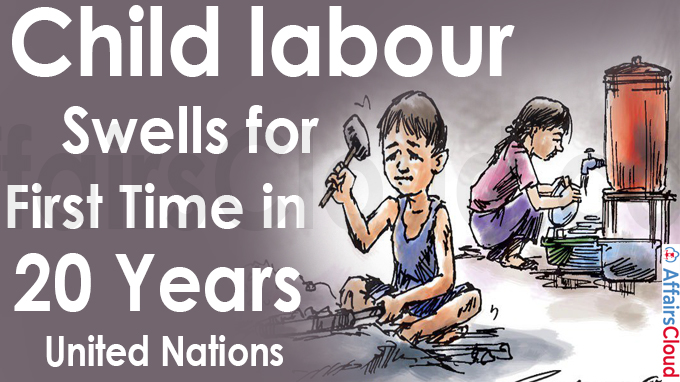 According to the ‘Child Labour Global Estimates 2020, trends and roads forward’ released by United Nations Children’s Fund (UNICEF) & International Labour Organization (ILO), for the 1st time in two decades, 160 million children (63 million girls and 97 million boys) were in child labour globally at the beginning of 2020, accounting for almost 1 in 10 of all children worldwide.
According to the ‘Child Labour Global Estimates 2020, trends and roads forward’ released by United Nations Children’s Fund (UNICEF) & International Labour Organization (ILO), for the 1st time in two decades, 160 million children (63 million girls and 97 million boys) were in child labour globally at the beginning of 2020, accounting for almost 1 in 10 of all children worldwide.
- The Child Labour estimates have been produced by ILO every 4 years since 2000.
- The world is not currently on a path to eradicate child labour by 2025 due to predictions before COVID-19 based on the speed of change from 2008 to 2016 it is close to 140 million of children will be child laborers by 2025.
- The Child Labour (160 million) registered an increase of 8.4 million over 4 years (2017-20). The number of children put to work fell by 94 million during 2000 and 2016.
- Due to COVID-19, globally 9 million additional children are at risk of being pushed into child labour by the end 2022. This may increase to 46 million if there is no access to critical social protection coverage.
Age wise concern
i.The report highlights the significant rise of children working between the ages of 5-11. This age group accounts for just over half of the total global figure (160 million).
ii.Number of children in the age group 5-17, who are working in hazardous places, which is likely to harm their health, safety or moral well-being has increased by 6.5 million since 2016 to 79 million.
Key Findings of the report
- Agriculture Sector accounts for 70% of children in child labour, followed by 20% in Services and 10% in Industry.
- Nearly 28% of 5-11 year-olds and 35% of those between 12-14 years in child labour, are out of school.
- Child labour in rural stands at 14%, which is three times higher than the 5% in urban areas.
Sub-Saharan Africa
- In sub-saharan African region, population growth, recurrent crises, extreme poverty and inadequate social protection measures have led to an additional 16.6 million children in child labour over the past 4 years (2017-20).
- It had the highest prevalence of child labour rate with 24% and largest number of children in child labour of around 87 million.
Measures to improve the situation
The report calls for adequate social protection, including universal child benefits; increased spending on quality education and getting all children back into school, including those forced out before COVID-19; and investment in child protection systems, rural public services and livelihoods to stop the upward trend in Child Labour.
Recent Related News:
March 23, 2021, According to the report ‘Reimagining WASH:Water Security For All’ released by UNICEF, globally more than 1.42 Billion people, including 450 million children live in areas of high, or extremely high, water vulnerability.
About United Nations Children’s Fund (UNICEF)
Executive Director – Henrietta H. Fore
Headquarters – New York, USA
About International Labour Organisation (ILO)
Members – 187
Director-General – Guy Ryder
Headquarters – Geneva, Switzerland




